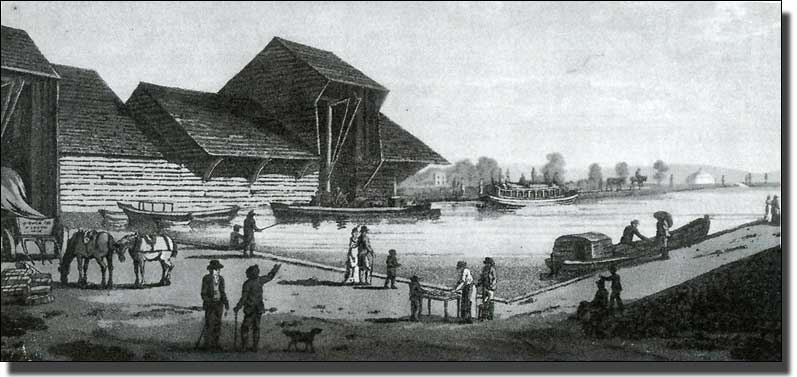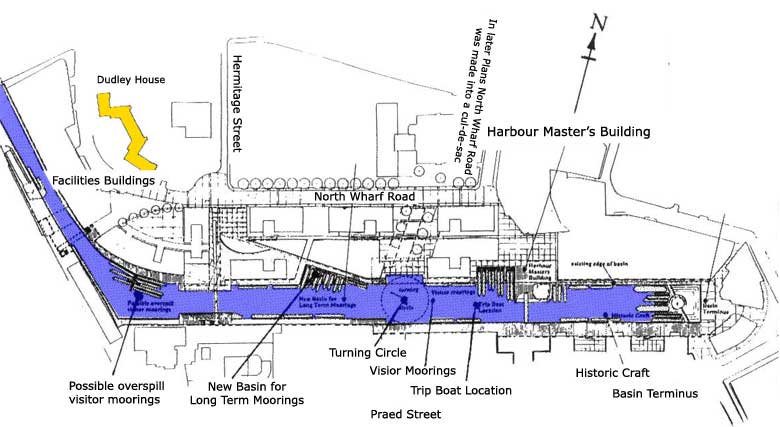Canal Boats Today
John Jones had started running passenger trips from Camden Lock in 1951, but the great change came over the Canal in the freeze of 1962. When the canal goods-carrying trade collapsed, it gave a great impetus to trip boats and the use of the waterways as a playground. With boats at give away prices, owners looked around for any way of making a living. One boat, the Ben Lawers, was owned by one of the horse-drawn barge families and was often used as a floating stage by Northside. Barges have been opened as restaurants or picture galleries, but the vast majority disappeared.
Canal Boat Trips
British Waterways used to run barge trips from Camden Lock to Little Venice for six weeks of the year. About 1986, Northside took over the line and began to run them for 52 weeks in the year. Ten years later they were carrying 50,000 passengers a year. To achieve these figures, Northside built up a fleet of their own which now plies regularly between Camden Town and Little Venice. It was planned for the trip to be later extended beyond Little Venice, right into the newly refurbished Paddington Basin.
The Perseus and Gardenia, both built in 1937, and The Jason, built in the 1960s, are narrow boats, The Jason was a wooden-bottomed working boat converted into a trip boat, while Perseus once carried coal. Both were converted into trip boats.
Northside commissioned Knight of Norfolk to build a glass-fibre boat called The Water Buffalo, to seat eighty. Gardenia and Perseus were completely overhauled and refurbished during the winter of 1994/95 and redecorated by signwriter and illustrator Barbara Card. After a weekend service during the winter, the boats began a daily service to and from Little Venice, each hour, on the hour. There are also day trips to more distant places like Limehouse, Three Mills (on the River Lee) and to Brentford via Little Venice.
All this movement is very leisurely. The old horse-drawn barges travelled at four miles an hour, the pace of a horse. Today, with a 24 horse powered engine instead of one horse, speed is still restricted by law to the same four miles an hour, but now it is to reduce erosion of the banks.
The Canal Towpath
Over the years the towpath has been opened up as a traffic-free footpath. In 1972 the stretch from Camden Town to the Zoo was opened and now there is free passage from the tunnel at Islington, through Camden Town and past the Zoo to the tunnel mouth under the Edgware Road at Maida Hill. Beyond this the towpath is open, by way of Little Venice, to Kilburn and beyond.
 Water Buffalo |
 Gardenia |
Paddy Walker and the Jenny Wren
Paddy Walker was a wonderful character, dynamic and vital. He was an art student at Kensington and later at Westminster School of Art. In 1928 he began as a student at the Working Men’s College in Camden Town and was soon teaching woodcarving and sculpture. By 1939 he was a governor of the College and remained so for the rest of his life. For him the College was to be run by teachers and students as they wished, without outside interference.
During the Second World War he made perfect scale models of newly designed ships to be made by men, skilled, but unable to read drawings. After 1945 he helped to restore St Paul’s Cathedral by creating wood-carvings to replace ones damaged by bombing. He returned to Camden Town to become a furniture restorer and carver, opening Walker’s Antiques in Camden High Street and living above the shop for the rest of his life.
He fought fiercely against the planned motorway, standing against the Conservatives as an anti-motorway candidate. With Viscount St David, he started the Pirate’s Club, the Camden boating club for children. In 1968 he commissioned the famous Jenny Wren and set up the Jenny Wren Canal Cruises, with their offices at Hampstead Road Bridge. Later he bought a second boat, ‘My Fair Lady’ and converted her into a floating restaurant. The Jenny Wren offices too were converted into the Waterside Restaurant, with splendid views over the canal. Shop, home, restaurant and boats, all were within a couple of hundred yards. As his friends said, “He was truly a Camden Town man.”1 In April 1998, the College in Crowndale Road opened a a newly refurbished art studio in his memory and named it ‘Paddy’s Room’.2

The Jenny Wren, with Paddy Walker, left, and Giles Baker who built her.
Paddington Basin - AD 1997
Over the years the ‘Jenny Wren’ has carried thousands of passengers from Camden Town to Little Venice, turning in the wide water at each end for the return trip. While Little Venice is very beautiful and tourists love to visit it, nobody would have wanted to go into Paddington Basin, only a few hundred yards further on. For years it had been empty and neglected. The Basin, which was so flourishing two centuries ago, lost all its trade after the great freeze of 1962-3. It became a backwater.
Thames Water and Paddington Basin Development Land Plc, planned to transform the Basin. Besides providing houses, shops and offices, it was to become a centre of water based activities and short-stay boat moorings. Barges would be able to moor for a few days and their crews to go to the West End, visit the large stores and theatres and then move on. They will come to London, bringing their own hotel rooms with them.
The Redevelopment Paddington Basin
The Canal Basin itself would be reshaped, widened here and narrowed there, but the total water area was to stay about the same as before. The plan shows a cafe at the far end, looking out on a display of Historic Craft. A new Harbour Master’s Building narrows the Basin, only for it to widen immediately to form visitors’ moorings. This will also be the new mooring for the tour barge, next to a widened Turning Circle, so that she can turn round for the return trip. Then come further moorings and, beyond the bridge at Bishop’s Bridge Road, will be a Facilities Building for visiting boats.
One end of this new building, itself would built like one half of a boat, with a curved awning roof, will be the original Canal Loading Building. This has the huge overhanging roof so typical of early canal engravings, which allowed barges to be loaded and unloaded in the dry. An engraving shows this particular barn standing alone beside an unfenced Basin, the very first of all the buildings. Now listed Grade II, it would be dismantled carefully, recorded, and moved from one end of the Basin to the other. It is somehow fitting that visiting barges in the 21st century should be greeted first and made welcome by a survivor from 1801.3

The first Barge-loading Building,
Paddington Canal Basin, 1801,
drawn by Henry Milbourne and engraved by Joseph Jeakes.
The Henry Milbourne drawing shows the original building shows the original Loading Building in 1801, the year the Grand Union Canal reached Paddington from the Midlands.

For two centuries the Loading Building was surrounded by factories and work.
The photograph shows the Grade II building in 1996,
photographed from the Metropole Hotel above.
 |
||
| Whole Plan | Full Size | Full Size Plan in New Window |
Paddington Basin Improvements
Planned for 2000
By 2011 a great deal of the rebuilding of Paddington Basin had been achieved. This will all be found later in the Marylebone & Paddington section of the book. The re-use of the first Barge-loading building has not yet been achieved and no doubt will depend on the success of the holiday barge scheme.
++PICTURES OF THE MODERN PADDINGTON BASIN. TO BE SELECTED
Footnote
